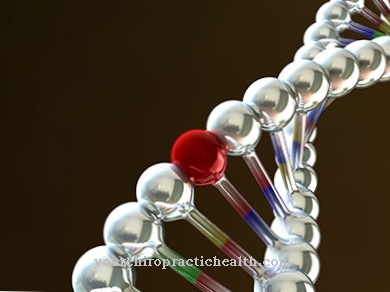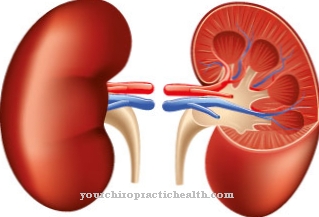A Nickel allergy occurs when the human skin or mucous membrane comes into contact with nickel. Women in particular often suffer from this contact allergy, which is usually harmless and heals up within a few days without complications. Affected patients should, however, permanently avoid contact with products containing nickel in order not to cause the contact eczema typical of nickel allergies.
What is a nickel allergy?

The very common one Nickel allergy it is an allergy that occurs when the skin or mucous membrane comes into contact with nickel or products containing nickel.
Nickel can be found in jewelry, glasses, cutlery, detergents, coins or zippers, for example. But food and luxury goods such as strawberries, cigarettes or nuts can also contain nickel and cause a nickel allergy.
This manifests itself as an inflammation of the skin, a so-called eczema, which often causes severe itching and a reddened skin rash. The eczema only occurs on the body part that has come into contact with nickel, which is typical of a nickel allergy.
causes
One cause one Nickel allergy lies in genetics, because this form of contact allergy is inherited in many cases. So if your own mother already suffers from a nickel allergy, the risk of developing this form of contact allergy in the course of life is significantly higher.
The rash that is typical of nickel allergies is caused by an immune system reaction when the skin comes into contact with nickel. Very sensitive people react to even the smallest amounts of nickel, which can be found in food, for example.
Symptoms, ailments & signs
The reaction in the case of a nickel allergy does not appear immediately upon contact with the material, but rather with a delay.The first symptoms only set in around twelve hours to three days after touching the nickel-containing object. The metal is released from jewelry, buttons or belts through body sweat and what is known as contact eczema forms at the touched areas. It is usually limited exactly to the points of contact.
The skin turns red and swells, wheals, pustules and fluid-filled blisters can form, accompanied by severe itching. Scratching worsens the skin reaction, delays healing, and allows infection. Nickel can also be ingested with food. The allergic reaction then shows up in the armpits, because nickel is excreted there in the sweat.
Oral ingestion can also cause old eczema that has already healed to flare up again. If components of dentures contain nickel, changes appear on the oral mucosa. Chronic contact eczema occurs when nickel is touched continuously or frequently. The skin becomes inflamed, thick and horny. Dandruff and painful cracks can form. In very rare cases, the skin symptoms spread over the whole body. One then speaks of generalized contact eczema, which is often associated with nausea, vomiting and fever.
Diagnosis & course
If a patient has a Nickel allergy, the treating dermatologist will first ask about the medical history. Usually the doctor can make a suspected diagnosis of a nickel allergy based on the patient's stories and the characteristic eczema.
To confirm this diagnosis, it is possible to carry out an allergy test, the so-called patch test. This recognizes whether the patient concerned has a nickel allergy. A substance containing nickel is applied to the skin under a plaster and the reaction of the skin is observed. If this shows the typical symptoms of a contact allergy, i.e. contact eczema, the diagnosis of a nickel allergy is confirmed.
In most cases, a nickel allergy does not pose a major health risk, provided that contact with nickel is permanently and consistently avoided. Only in very rare cases can the nickel allergy turn into chronic eczema, which must be treated with special medication or forms of therapy.
Complications are only to be expected if contact with nickel is not permanently avoided, for example if the patient's dental implants contain nickel. In these very rare cases, the products containing nickel must be removed as quickly as possible in order to rule out serious complications of the nickel allergy.
Complications
Without treatment, a nickel allergy can lead to permanent skin changes. After the initial formation of nodules and vesicles, the skin begins to ooze. Redness appears and purulent pustules form. There is an increased formation of scales, the skin tears and can in places become inflamed and sometimes keratinized.
The scratching of the skin as a result of the itching that occurs has a negative effect on the local inflammation and leads to further infections. The allergic reaction can then spread to other areas of the body. Skin that is scratched deeper tends to form scar tissue. The susceptibility of the affected skin to an attack by fungi and bacteria increases. In addition, severe itching is a psychological burden for those affected.
Complications are possible if the allergy is caused by a prosthesis in the body that contains nickel. A dental prosthesis can trigger a change in the mucous membrane in the mouth. During treatment with cream, lotion or ointment, the skin's appearance may temporarily deteriorate.
Using prescribed cortisone ointments for too long can cause side effects in the form of thinning of the skin and hyperpigmentation. Disturbances in the healing process of the skin can occur through the use of unsuitable body care products that cause the skin to burn and tense.
When should you go to the doctor?
A nickel allergy is not uncommon, but lay people like to equate it with an incompatibility of the material. This is even more common; many people are sensitive to nickel. In the event of such a reaction, the doctor should be consulted the first time it occurs, because it must be clarified whether the skin is only sensitive or whether it is actually a nickel allergy.
In the case of an allergy, on the one hand it is possible that there are other allergies. This can be tested for immediately so that the person affected can avoid contact with other possible allergens in order not to have to struggle with symptoms in the first place. On the other hand, the person affected must know about the allergy so that he can protect himself from contact with nickel in the future. If you have a known nickel allergy, you must pay close attention to cheap jewelry.
If skin or other contact with nickel has arisen in the case of a known nickel allergy, a visit to the doctor makes sense if the reaction to it is either particularly violent or if there is an unfamiliar reaction of the body that the person concerned has not experienced before. Often the case occurs that the person concerned only realizes after a few hours of wearing that a piece of jewelry must contain nickel.
Treatment & Therapy
At a Nickel allergy The first step in treatment is to avoid contact with the allergenic substance. Patients should completely avoid products containing nickel and also take care not to consume any nickel in their diet.
However, the effectiveness of a nickel-free diet cannot be proven with absolute certainty. If there is no significant improvement in the condition within three months, the nickel diet can be discontinued.
If a nickel allergy causes contact eczema, the dermatologist usually prescribes an anti-inflammatory ointment or cream for his patients, which at the same time alleviates the itching and has a calming effect on the skin. You can also choose from preparations that have an anti-allergic effect and support the skin in healing eczema. It usually only takes a few days for the skin to recover from contact eczema that can be traced back to a nickel allergy.
Outlook & forecast
As soon as a nickel allergy has been diagnosed, this fact persists in the long term. A cure is not possible, but the prognosis for an uncomplicated course is good. From the time of sensitization, a symptom-free life is possible if those affected avoid contact with nickel. Complaints and symptoms that have occurred then usually disappear within two to three weeks. It is all the more important that the diet consistently adheres to a low-nickel diet for a period of at least two to three months.
However, if the symptoms have persisted for a long time due to the allergy, the affected areas of the skin can be particularly susceptible to bacterial or fungal attack. There is a noticeable sensation of warmth, severe reddening, as well as swelling or pain. Medically prescribed drug treatment of the infection is urgently indicated, depending on the pathogen. It is therefore necessary to always inform the attending physician about the presence of a nickel allergy. In addition, nickel allergy sufferers should note that a rejection reaction can occur if a bone fracture has been treated with metal surgery.
A nickel allergy can also have an impact in the professional field. Regardless of whether there is frequent contact with water or a comparable stressing of the skin surface. A spread of the nickel allergy and further contact allergies can result.
prevention
People who have a family member at a Nickel allergy should definitely avoid products containing nickel. In this way you can avoid the outbreak of a nickel allergy. In the case of a known nickel allergy, affected patients should avoid contact with substances containing nickel so that contact dermatitis, which is typical for a nickel allergy, does not develop.
Aftercare
The aftercare aims, among other things, to prevent the recurrence of a disease. This is possible with a nickel allergy, but is not primarily the responsibility of a doctor. Rather, patients must independently avoid objects containing nickel. This avoids the typical symptoms.
As a result, those affected lead a symptom-free life. Such a precautionary measure is sufficient, especially for mild forms. In addition, follow-up care may also require long-term treatment. Patients then often have to take cortisone in tablet form. The doctor and patient agree to have regular follow-ups. In addition to a detailed discussion about the symptoms, the skin of the body is examined for damage.
Because inflammations usually develop on it. Damage makes the natural skin barrier more susceptible to a reaction. In the case of a serious illness, a diet that is low in nickel is sometimes recommended. However, this should only be carried out after consulting a doctor. Dieting may reduce complications.
The personal responsibility with an allergy is usually very high. Many unwanted reactions arise in everyday life. Therefore, as part of the follow-up care, the patient should examine his surroundings for substances containing nickel. In addition, protective measures such as gloves should be in place. The treating dermatologist will provide instructions on how to behave on request.
You can do that yourself
For people who are affected by a nickel allergy, there are some ways to alleviate the symptoms in everyday life - however, awareness of the product will last a lifetime.
First of all, of course, any contact with nickel should be avoided. It is important to note in which areas nickel can be used. The fabric may be found in costume jewelry or eyeglass temples. Nickel can also be found in clothing, for example in bra straps or jeans buttons. What those affected are often not aware of is that nickel can also be present in gold jewelry - even if only in small quantities. Therefore, gold jewelry is only a problem for a small proportion of nickel allergy sufferers.
The consumption of tobacco should definitely be avoided by those affected. Tobacco smoke can make the symptoms of the disease significantly worse or even cause them to arise in the first place. This rule also applies to secondhand smoke. Nickel allergy sufferers should therefore not visit places or places where smoking is allowed. It is also helpful to take good care of the skin. Moisturizing creams or oils are recommended here.

.jpg)
.jpg)


.jpg)





















